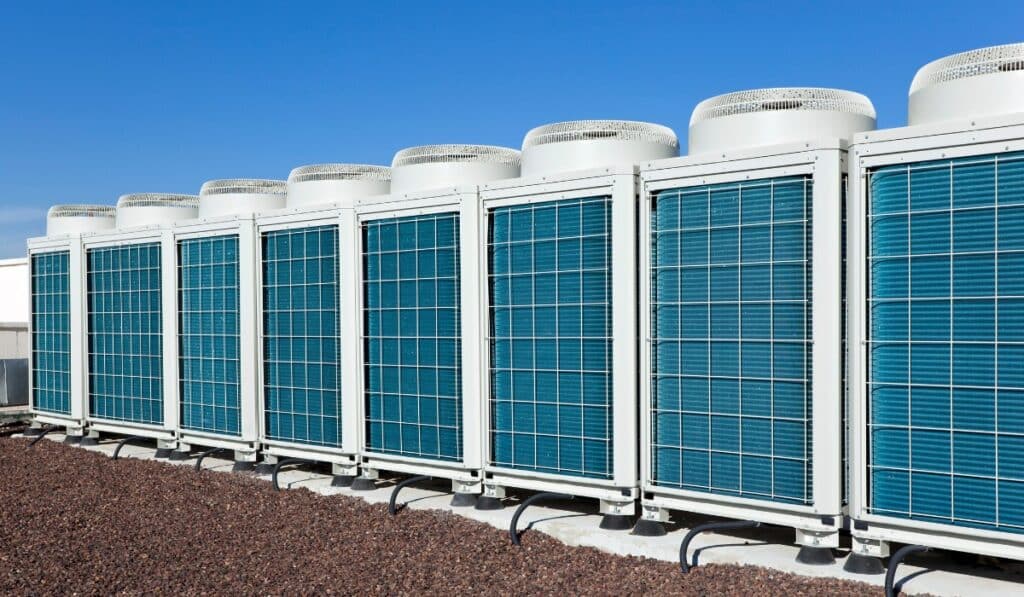An HVAC (heating, ventilation, and air conditioning) system is a crucial component in both residential and commercial buildings. It is responsible for regulating indoor air quality, temperature, and humidity levels, ensuring a comfortable and healthy living or working environment. Understanding the different types of HVAC systems is essential for selecting the right system for your needs and maximizing its efficiency.
The Main Components of an HVAC System
Before delving into the various types of HVAC systems, it’s essential to understand the main components that make up these systems:
- Air Handling Unit (AHU): This component is responsible for circulating and conditioning the air within a building. It typically includes a blower, heating and cooling elements, and air filters.
- Ductwork: A network of ducts that distributes conditioned air throughout the building.
- Thermostat: The thermostat is the control center that allows you to set and maintain the desired temperature in your living or working space.
- Refrigerant Lines: These lines carry refrigerant between the indoor and outdoor units in a split system, facilitating the cooling process.
- Condensing Unit: The outdoor unit that releases heat from the refrigerant during the cooling cycle.
With these essential components in mind, let’s explore the different types of HVAC systems available.
Centralized HVAC Systems
Split Systems
Split systems are one of the most common types of centralized HVAC systems found in residential and commercial buildings. As the name suggests, these systems are divided into two main units: an indoor unit (air handler) and an outdoor unit (condensing unit).
The indoor unit is responsible for circulating and conditioning the air within the building, while the outdoor unit handles the heat transfer process. Split systems can be further classified into:
- Air-Source Heat Pumps: These systems use the outdoor air as a heat source during the heating cycle and a heat sink during the cooling cycle. They are highly efficient and can provide both heating and cooling functions.
- Ductless Mini-Split Systems: These systems are similar to traditional split systems but do not require ductwork. Instead, they use individual air handlers mounted on the walls or ceilings of each room, providing zoned heating and cooling.
Packaged HVAC Systems
Packaged HVAC systems are self-contained units that house all the necessary components (air handler, compressor, condenser, and evaporator) in a single cabinet. These systems are commonly found in commercial and industrial buildings, as well as some residential applications.
The main advantages of packaged HVAC systems include:
- Space-saving design
- Easy installation and maintenance
- Cost-effective for smaller applications
Variable Refrigerant Flow (VRF) Systems
Variable Refrigerant Flow (VRF) systems are advanced centralized HVAC systems that offer superior energy efficiency and zoning capabilities. These systems consist of an outdoor condensing unit connected to multiple indoor units through refrigerant piping.
Key features of VRF systems include:
- Precise temperature control for individual zones
- Energy-efficient operation by modulating refrigerant flow
- Simultaneous heating and cooling capabilities
- Flexible design for various building types and sizes
Decentralized HVAC Systems

Window Air Conditioners
Window air conditioners are a common decentralized HVAC solution for single rooms or small spaces. These units are designed to be installed in a window or through a wall, providing localized cooling and, in some cases, heating capabilities.
Key advantages of window air conditioners include:
- Easy installation
- Affordable upfront cost
- Suitable for small spaces or supplemental cooling
However, window units are less energy-efficient than centralized systems and may not provide even temperature distribution throughout the space.
Portable Air Conditioners
Portable air conditioners are another decentralized HVAC option that offers flexibility and convenience. These units are self-contained and can be moved from one room to another, making them an excellent choice for temporary cooling needs or situations where permanent installation is not feasible.
Portable air conditioners typically feature:
- Casters for easy mobility
- Exhaust hose to vent hot air outside
- Self-evaporating or manual draining of condensate
While portable air conditioners offer convenience, they may be less energy-efficient than other HVAC systems and require proper ventilation to function correctly.
Ductless Mini-Split Systems (Decentralized)
While ductless mini-split systems can be considered centralized HVAC systems, they can also be installed as decentralized units for individual rooms or zones. In this configuration, each indoor air handler is connected directly to an outdoor condensing unit, providing localized heating and cooling without the need for ductwork.
Decentralized ductless mini-split systems offer advantages such as:
- Zoned temperature control
- Energy efficiency
- Flexible installation options
- No ductwork required
Heating Systems
While some HVAC systems provide both heating and cooling capabilities, certain systems are dedicated specifically to heating. These include:
Furnaces
Furnaces are a common heating solution in residential and commercial buildings. They work by burning fuel (such as natural gas, propane, or oil) to generate heat, which is then distributed throughout the building via ductwork.
Key features of furnaces include:
- Energy efficiency ratings (AFUE)
- Varying fuel types (natural gas, propane, oil, electric)
- Compatibility with central air conditioning systems
Proper maintenance and regular filter changes are crucial for ensuring the safe and efficient operation of furnaces.
Boilers
Boilers are another popular heating system, particularly in colder climates or larger buildings. They work by heating water or steam, which is then circulated through pipes or radiators to provide warmth throughout the building.
Boilers can be classified into different types based on their fuel source (natural gas, propane, oil, or electricity) and distribution method (hot water or steam). Some common types of boilers include:
- Hot water boilers
- Steam boilers
- Condensing boilers (high-efficiency)
Regular maintenance and water treatment are essential for boiler systems to ensure efficient and safe operation.
Radiant Heating Systems
Radiant heating systems offer a unique and energy-efficient method of heating buildings. These systems work by circulating heated water or electric cables through a network of pipes or cables installed beneath the floor or within the walls or ceilings.
The main advantages of radiant heating systems include:
- Even heat distribution
- Improved indoor air quality (no forced air)
- Energy efficiency
- Customizable zoning capabilities
Radiant heating systems can be integrated with other HVAC components, such as heat pumps or boilers, to provide a comprehensive heating solution.
Ventilation Systems
Proper ventilation is crucial for maintaining indoor air quality and ensuring a healthy indoor environment. Ventilation systems work by introducing fresh outdoor air and removing stale indoor air, reducing the buildup of pollutants, moisture, and odors.
Exhaust Fans
Exhaust fans are a simple yet effective ventilation solution for bathrooms, kitchens, and other areas prone to high humidity or odors. These fans work by removing stale air from the space and expelling it outside the building.
Energy Recovery Ventilators (ERVs)
Energy Recovery Ventilators (ERVs) are advanced ventilation systems that exchange stale indoor air with fresh outdoor air while recovering energy from the outgoing air stream. This process helps maintain indoor air quality while minimizing energy losses associated with heating or cooling the incoming fresh air.
ERVs are often integrated with other HVAC components to provide comprehensive indoor air quality management.
Heat Recovery Ventilators (HRVs)
Heat Recovery Ventilators (HRVs) are similar to ERVs but focus specifically on recovering heat from the outgoing air stream. This recovered heat is then used to pre-condition the incoming fresh air, improving energy efficiency and reducing heating costs.
HRVs are particularly beneficial in colder climates where maintaining indoor air quality while minimizing heat loss is a priority.
Hybrid HVAC Systems

In recent years, hybrid HVAC systems have gained popularity due to their ability to combine multiple technologies and energy sources for improved efficiency and performance.
Hybrid Heat Pump Systems
Hybrid heat pump systems combine an electric air-source heat pump with a secondary heating source, such as a furnace or boiler. This configuration allows the system to operate in the most efficient and cost-effective mode based on outdoor temperatures and heating demands.
During milder weather Here’s the continuation of the blog post:
During milder weather conditions, the heat pump can efficiently provide heating and cooling, while the secondary heating source (furnace or boiler) kicks in during extreme cold temperatures to ensure consistent and reliable heating.
Geothermal Heat Pump Systems
Geothermal heat pump systems are a highly efficient and environmentally friendly HVAC solution that leverages the constant temperature of the earth to provide heating and cooling. These systems consist of an indoor heat pump unit connected to a series of underground pipes filled with a water or refrigerant solution.
During the heating cycle, the geothermal heat pump absorbs heat from the earth and transfers it indoors, while in the cooling cycle, it extracts heat from the building and transfers it back into the ground.
Key advantages of geothermal heat pump systems include:
- High energy efficiency
- Reduced greenhouse gas emissions
- Longer lifespan and minimal maintenance requirements
- Compatibility with radiant heating systems
While the initial installation costs are higher, geothermal systems can offer significant long-term cost savings and environmental benefits.
Smart HVAC Systems and Controls
With the advent of smart home technology, HVAC systems have also evolved to incorporate intelligent controls and automation features. Smart HVAC systems offer enhanced energy efficiency, convenience, and personalized comfort.
Smart Thermostats
Smart thermostats are the centerpiece of intelligent HVAC systems. These advanced thermostats can learn your preferences and adjust temperatures automatically based on occupancy, weather conditions, and user schedules. Many smart thermostats also offer remote access and control through mobile apps or voice commands.
Zoning Systems
Zoning systems allow you to divide your living or working space into separate temperature-controlled zones. This feature is particularly beneficial in larger buildings or homes with varying heating and cooling needs in different areas.
Zoning systems typically consist of multiple thermostats and dampers installed in the ductwork to regulate airflow and temperature in each zone independently.
Home Automation Integration
Many modern HVAC systems can be integrated with home automation platforms, such as Amazon Alexa, Google Home, or Apple HomeKit. This integration allows you to control your HVAC system using voice commands or through a centralized smart home app, providing convenient and seamless home management.
HVAC System Maintenance and Repair
Proper maintenance and timely repairs are crucial for ensuring the efficient and reliable operation of your HVAC system. Regular maintenance can help extend the lifespan of your system, improve indoor air quality, and prevent costly breakdowns.
Here are some essential HVAC maintenance tasks:
- Air filter replacement
- Coil cleaning
- Refrigerant level checks
- Thermostat calibration
- Ductwork inspection and cleaning
- Electrical component testing
It’s recommended to have your HVAC system inspected by a professional technician at least once a year to identify and address any potential issues before they escalate.
If you encounter any problems with your HVAC system, such as strange noises, inadequate heating or cooling, or high energy bills, it’s essential to seek professional repair services promptly. Attempting DIY repairs on HVAC systems can be dangerous and may even void manufacturer warranties.
Final Note
If you’re in need of professional HVAC maintenance, repair, or installation services in the Los Angeles area, look no further than Top AC Inc. Our team of certified technicians is dedicated to providing exceptional service and ensuring your HVAC system runs efficiently and reliably. Contact us today or visit our website to schedule an appointment or request a free consultation.

